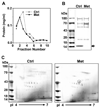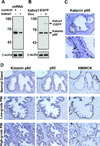Aberrant expression of katanin p60 in prostate cancer bone metastasis
- PMID: 21681775
- PMCID: PMC3179562
- DOI: 10.1002/pros.21431
Aberrant expression of katanin p60 in prostate cancer bone metastasis
Abstract
Background: Katanin p60 is a microtubule-severing protein and is involved in microtubule cytoskeleton organization in both mitotic and non-mitotic processes. Its role in cancer metastasis is unknown.
Methods: Differential protein profiles of bone marrow aspirates were analyzed by chromatography, electrophoresis, and mass spectrometry. Expression of katanin p60 in primary and metastatic prostate cancer was examined by immunohistochemistry. Cellular function of katanin p60 was further examined in prostate cell lines.
Results: In a proteomic profiling of bone marrow aspirates from men with prostate cancer, we found that katanin p60 was one of the proteins differentially expressed in bone metastasis samples. Immunohistochemical staining showed that katanin p60 was expressed in the basal cells in normal human prostate glands. In prostatic adenocarcinomas, in which the basal cells were absent, katanin p60 was expressed in the prostate cancer cells. In the specimens from bone metastasis, katanin p60 was detectable in the metastatic cancer cells. Strikingly, some of the metastatic cancer cells also co-expressed basal cell biomarkers including the tumor suppressor p53-homologous protein p63 and the high molecular weight cytokeratins, suggesting that the metastatic prostate cancer cells may have a basal cell-like phenotype. Moreover, overexpression of katanin p60 inhibited prostate cancer cell proliferation but enhanced cell migration activity.
Conclusions: Katanin p60 was aberrantly expressed during prostate cancer progression. Its expression in the metastatic cells in bone was associated with the re-emergence of a basal cell-like phenotype. The elevated katanin p60 expression may contribute to cancer cell metastasis via a stimulatory effect on cell motility.
Copyright © 2011 Wiley Periodicals, Inc.
Conflict of interest statement
The authors declared no potential conflicts of interest with respect to the authorship and/or publication of this article.
Figures






Similar articles
-
The role of katanin p60 in breast cancer bone metastasis.Oncol Lett. 2018 Apr;15(4):4963-4969. doi: 10.3892/ol.2018.7942. Epub 2018 Feb 2. Oncol Lett. 2018. PMID: 29552132 Free PMC article.
-
TAp63 and ΔNp63 (p40) in prostate adenocarcinomas: ΔNp63 associates with a basal-like cancer stem cell population but not with metastasis.Virchows Arch. 2021 Apr;478(4):627-636. doi: 10.1007/s00428-020-02944-z. Epub 2020 Oct 10. Virchows Arch. 2021. PMID: 33037932
-
Katanin subunits p60 and p80, potential biomarkers for papillary thyroid carcinoma to distinguish nodular goiter: STROBE.Medicine (Baltimore). 2022 Jun 17;101(24):e29402. doi: 10.1097/MD.0000000000029402. Medicine (Baltimore). 2022. PMID: 35713446 Free PMC article.
-
Bone Marrow Microenvironment as a Regulator and Therapeutic Target for Prostate Cancer Bone Metastasis.Calcif Tissue Int. 2018 Feb;102(2):152-162. doi: 10.1007/s00223-017-0350-8. Epub 2017 Nov 1. Calcif Tissue Int. 2018. PMID: 29094177 Free PMC article. Review.
-
NFkappaB: a pivotal transcription factor in prostate cancer metastasis to bone.Clin Orthop Relat Res. 2003 Oct;(415 Suppl):S75-85. doi: 10.1097/01.blo.0000093048.96273.aa. Clin Orthop Relat Res. 2003. PMID: 14600595 Review.
Cited by
-
Molecular regulation of bone marrow metastasis in prostate and breast cancer.Bone Marrow Res. 2014;2014:405920. doi: 10.1155/2014/405920. Epub 2014 Jul 23. Bone Marrow Res. 2014. PMID: 25147739 Free PMC article. Review.
-
The Mammalian Family of Katanin Microtubule-Severing Enzymes.Front Cell Dev Biol. 2021 Aug 3;9:692040. doi: 10.3389/fcell.2021.692040. eCollection 2021. Front Cell Dev Biol. 2021. PMID: 34414183 Free PMC article. Review.
-
Organelle-Derived Acetyl-CoA Promotes Prostate Cancer Cell Survival, Migration, and Metastasis via Activation of Calmodulin Kinase II.Cancer Res. 2018 May 15;78(10):2490-2502. doi: 10.1158/0008-5472.CAN-17-2392. Epub 2018 Mar 13. Cancer Res. 2018. PMID: 29535221 Free PMC article.
-
Katanin P60: a potential biomarker for lymph node metastasis and prognosis for non-small cell lung cancer.World J Surg Oncol. 2020 Jul 6;18(1):157. doi: 10.1186/s12957-020-01939-z. World J Surg Oncol. 2020. PMID: 32631334 Free PMC article.
-
Engagement of DYRK2 in proper control for cell division.Cell Cycle. 2015;14(6):802-7. doi: 10.1080/15384101.2015.1007751. Cell Cycle. 2015. PMID: 25603354 Free PMC article. Review.
References
-
- Bubendorf L, Schopfer A, Wagner U, Sauter G, Moch H, Willi N, Gasser TC, Mihatsch MJ. Metastatic patterns of prostate cancer: an autopsy study of 1,589 patients. Hum Pathol. 2000;31(5):578–583. - PubMed
-
- Shah RB, Mehra R, Chinnaiyan AM, Shen R, Ghosh D, Zhou M, Macvicar GR, Varambally S, Harwood J, Bismar TA, Kim R, Rubin MA, Pienta KJ. Androgen-independent prostate cancer is a heterogeneous group of diseases: lessons from a rapid autopsy program. Cancer Res. 2004;64(24):9209–9216. - PubMed
-
- McNally FJ, Vale RD. Identification of katanin, an ATPase that severs and disassembles stable microtubules. Cell. 1993;75(3):419–429. - PubMed
Publication types
MeSH terms
Substances
Grants and funding
LinkOut - more resources
Full Text Sources
Other Literature Sources
Medical
Research Materials
Miscellaneous

